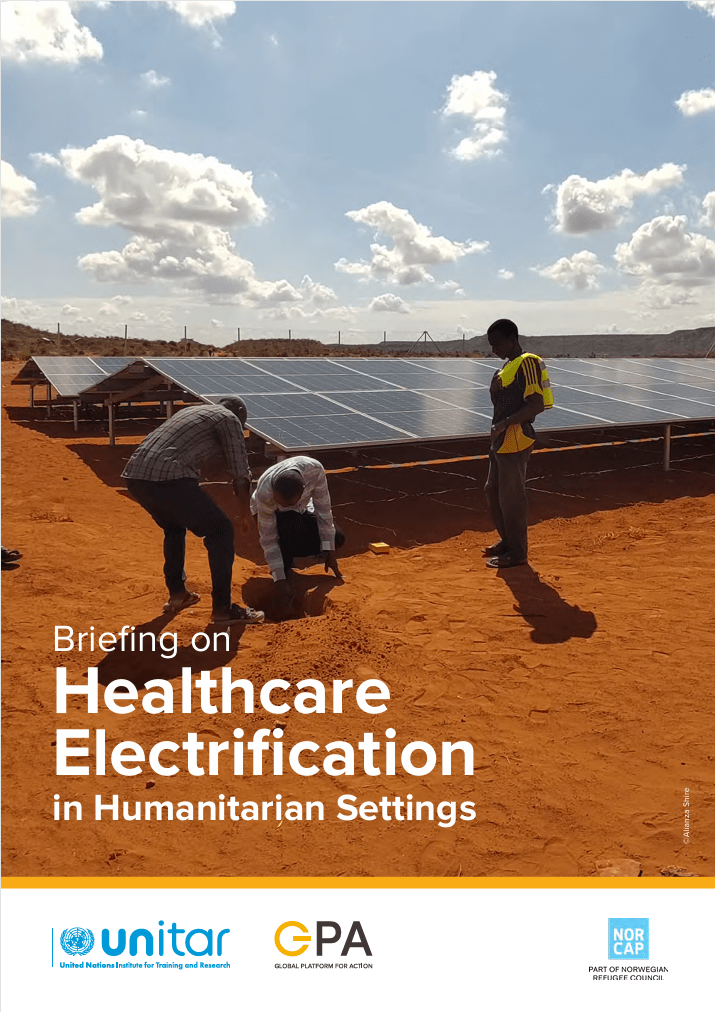Briefing on healthcare electrification in humanitarian settings
 |
rapport Feb 2025 ; 84 pages
Aut. Jonathan Archimi & Shahaab Javeri & Katherine Patterson
Ed. NRC - Oslo UNITAR - Genève
Téléchargeable sous format: PdF
Téléchargeable chez l'éditeur
Résumé:
L’accès à l’énergie représente un obstacle important à une prestation efficace des soins de santé, et on estime que, dans le monde entier, un milliard de personnes recherchent des soins auprès d’installations qui ne disposent pas d’électricité fiable ou n’en ont aucune. Le problème est particulièrement important en Afrique subsaharienne où seulement 28% des établissements de santé disposent d’un approvisionnement fiable en électricité.
Les acteurs du développement dans les domaines de l’accès à l’énergie et des soins de santé ont cherché à relever ce défi en lançant plusieurs partenariats à grande échelle pour combler le fossé mondial en matière d’électrification des soins de santé, souvent en tirant parti du potentiel des sources d’énergie renouvelables distribuées, et en particulier la technologie solaire.
Le présent rapport définit le déficit d’électrification des soins de santé humanitaires et en identifie les causes. Les défis qui entravent le maintien et l’expansion de l’approvisionnement en électricité de ces installations comprennent notamment les cycles budgétaires à court terme pour les activités humanitaires, le manque de capacité financière et de gestion chez les partenaires gouvernementaux responsables de la gestion ou la difficulté d’exploiter les capacités disponibles. Abstract:
Energy access represents a significant barrier to effective healthcare delivery, and it is estimated that globally, one billion people seek care from facilities that have unreliable electricity or none at all. The issue is particularly acute in sub-Saharan Africa, where only 28 per cent of healthcare facilities have reliable electricity supply.
Development partners in the energy access and healthcare spaces have sought to tackle this challenge by launching several large-scale partnerships to close the global healthcare electrification gap, in many cases by leveraging the potential of distributed renewable energy sources, and in particular, solar technology. The healthcare electrification gap is particularly acute in fragile and displacement settings, where many facilities are underpowered or completely without electricity.
The present report defines the humanitarian healthcare electrification gap and identifies its causes. In particular, challenges that hinder the maintenance and expansion of the electricity supply to these facilities include short-term humanitarian budget cycles, a lack of financial and management capacity among government partners responsible for long-term stewardship, or difficulty in operationalising available capacity. Contents:
Executive Summary 5
About this Report 7
1. The Energy-Healthcare Nexus 9
2. Energy in Humanitarian Healthcare Facilities 1
3. HHF Electrification Pipeline 20
4. Case Studies for Closing the Gap 24
HUMANITARIAN ORGANISATION-LED ELECTRIFICATION CASE STUDIES 26
DEVELOPMENT ORGANISATION-LED CASE STUDIES 43
HEALTHCARE ELECTRIFICATION INVESTMENT CASES 56
5. Closing the Humanitarian Healthcare Gap 73
Public-Cible:
Mots clefs: |
accès à l’électricité (CI) (DT) (OP) (ope) , humanitaire, urgentiste (CI) (DT) (OP) (ope) , santé (CI) (DT) (OP) (ope) |
Pays concernés: |
Ethiopie (CI) (DT) (OP) , Inde (CI) (DT) (OP) , Kenya (CI) (DT) (OP) , Madagascar (CI) (DT) (OP) , Mauritanie (CI) (DT) (OP) , Ouganda (CI) (DT) (OP) , Sao Tome e Principe (CI) (DT) (OP) , Sierra Leone (CI) (DT) (OP) , Somalie (CI) (DT) (OP) , Tanzanie (CI) (DT) (OP) |
Editeurs/Diffuseurs: |
|
NRC
-
Norwegian Refugee Council - Oslo - Norvège |
UNITAR
-
United Nations Institute for Training and Research - Genève - Suisse |
En cas de lien brisé, nous le mentionner à communication@pseau.org